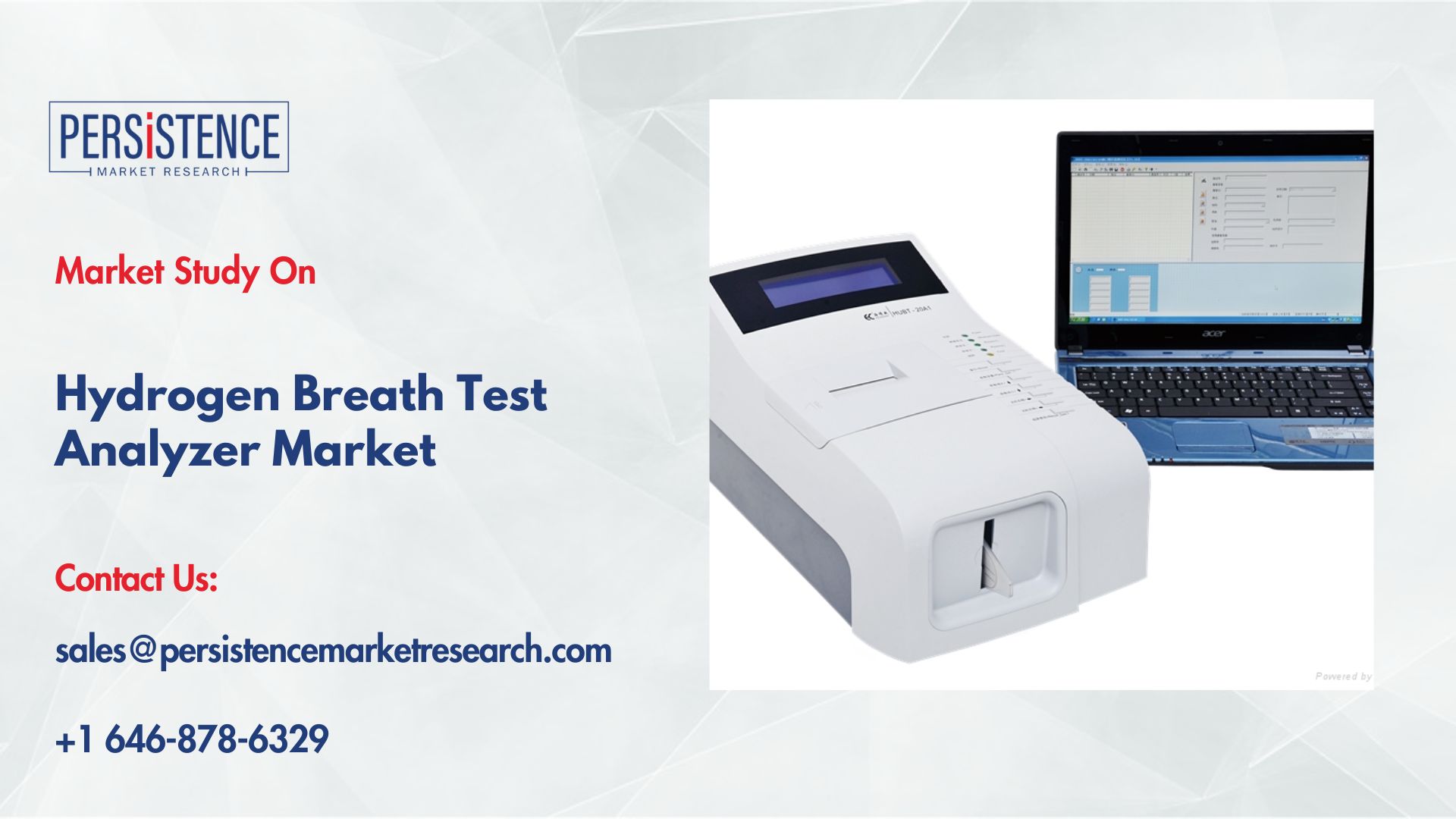Hydrogen Breath Test Analyzer Market Grows with Portable and Handheld Demand

Strong 8k brings an ultra-HD IPTV experience to your living room and your pocket.
Introduction: The Evolution of Non-Invasive Diagnostics
As the global burden of gastrointestinal (GI) disorders continues to rise, the demand for non-invasive, patient-friendly diagnostic tools has surged. Among these, hydrogen breath test (HBT) analyzers have gained increasing attention for their clinical utility in diagnosing metabolic and GI conditions. The hydrogen breath test analyzer market is projected to grow from US$ 36.23 million in 2025 to US$ 52.01 million by 2032, expanding at a CAGR of 5.3% during the forecast period. This market growth is rooted in technological innovation, shifting clinical practices, and increasing healthcare access, particularly in emerging economies.
In this article, we delve into the major trends, market dynamics, segmentation insights, and future outlook of the hydrogen breath test analyzer market.
1. Understanding Hydrogen Breath Test Analyzers
Hydrogen breath tests analyze exhaled breath for hydrogen levels produced by bacterial fermentation in the gut. These tests are commonly used to diagnose conditions such as:
• Lactose intolerance
• Small intestinal bacterial overgrowth (SIBO)
• Fructose intolerance
• Irritable bowel syndrome (IBS)
These tests are non-invasive, cost-effective, and reliable, making them attractive for both clinicians and patients. Breath test analyzers detect hydrogen (and sometimes methane) gases produced when unabsorbed carbohydrates are fermented by bacteria in the colon or small intestine.
2. Market Size and Growth Projections
According to estimates:
• 2025 Market Value: US$ 36.23 million
• 2032 Forecast Value: US$ 52.01 million
• CAGR (2025–2032): 5.3%
• Historical CAGR (2019–2024): 3.9%
This upward trajectory reflects increased awareness, better screening initiatives, and rapid advancements in diagnostic technology.
3. Market Dynamics
A. Key Drivers
i. Rising Incidence of GI Disorders
The increasing prevalence of GI conditions such as IBS, SIBO, and lactose intolerance is a core driver of market growth. For instance:
• Over 2.28 billion prevalent cases of digestive disorders were reported globally in 2019.
• IBS alone affects 10%–15% of adults in the U.S., with up to 40% of the global population experiencing some form of FGID.
This high disease burden fuels demand for early, accurate diagnosis—offered effectively through HBT analyzers.
ii. Shift Toward Non-Invasive Testing
Hydrogen breath tests are painless, radiation-free, and simple to administer. This trend aligns with the broader movement away from invasive GI diagnostics (like endoscopies), thus enhancing patient compliance and streamlining clinic workflows.
iii. Technological Advancements
The development of solid-state and electrochemical sensors is revolutionizing breath analyzers by:
• Increasing sensitivity
• Reducing analysis time
• Improving portability
• Enabling multi-gas detection (hydrogen, methane, etc.)
B. Market Restraints
i. Lack of Standardized Testing Protocols
Despite widespread usage, hydrogen breath test interpretation suffers from inconsistencies in:
• Test substrates (e.g., glucose vs. lactulose)
• Testing durations
• Cut-off values for hydrogen/methane
• Sample collection timings
This variability can result in inconclusive or incorrect diagnoses, discouraging some clinicians and limiting broader market adoption.
ii. Limited Reimbursement Policies
In some regions, reimbursement for HBTs is limited or inconsistent, making adoption slower in cost-sensitive markets.
C. Emerging Opportunities
i. Integration of Digital Health Platforms
Companies like Owlstone Medical are pioneering digital platforms (e.g., OMED Health) that integrate diagnostic hardware with mobile applications and cloud data. These platforms enable:
• Remote testing and data capture
• Real-time analytics
• Personalized GI health management
ii. Expansion in Emerging Economies
Rising disposable incomes, urbanization, and growing healthcare infrastructure in Asia-Pacific and Latin America present strong growth opportunities. These regions are investing heavily in decentralized diagnostics and mobile health technologies.
4. Category-Wise Market Insights
A. Product Type Analysis
Portable Analyzers
These are designed for clinical environments, offering high-throughput testing for up to 10 patients per session. Ideal for hospitals, outpatient clinics, and diagnostic centers.
Handheld Analyzers
Compact and lightweight, these devices are gaining popularity due to their suitability for point-of-care and home-based testing. They reduce the need for hospital visits and promote patient autonomy.
Accessories and Consumables
These include breath bags, tubing, test substrates (glucose, lactose), and calibration tools. They represent a recurring revenue stream for manufacturers.
B. Sensor Type Analysis
Solid-State Sensors
Currently dominating the market, solid-state sensors offer:
• High durability
• Minimal maintenance
• Enhanced accuracy
• Suitability across diverse environmental conditions
Electrochemical Sensors
Though limited by shorter lifespans and environmental sensitivity, they offer cost-effective solutions and are widely used in emerging market devices.
C. Application Segmentation
• Lactose Intolerance: Most common application. Prevalence among adults is increasing, especially in Asian and African populations.
• SIBO: Rising awareness and diagnosis rates make this a fast-growing segment.
• Fructose Intolerance & Others: Emerging areas with growing clinical significance.
D. End-User Insights
• Hospitals & Outpatient Centers: Major revenue contributors due to the presence of specialized gastroenterology departments.
• Diagnostic Laboratories: Centralized labs often perform high-volume testing.
• Pediatric Clinics: Increased testing for carbohydrate malabsorption disorders in children.
• Homecare Settings: Growth driven by handheld analyzers and telemedicine integration.
5. Regional Analysis
A. North America
• Largest market share
• Strong presence of key players
• High awareness and reimbursement coverage
B. Europe
• Strong regulatory framework
• Focus on non-invasive diagnostics
• Increasing government support for early diagnosis
C. Asia-Pacific
• Fastest growing region
• Expanding middle-class population and health literacy
• Growing demand for affordable and accessible diagnostic tools
D. Latin America & Middle East and Africa
• Emerging markets
• Government initiatives for early disease detection
• Untapped growth potential in rural diagnostics
6. Competitive Landscape
The hydrogen breath test analyzer market is competitive with several established players and emerging startups vying for market share. Strategies include:
• Technological innovation
• Geographic expansion
• Strategic partnerships
• Product portfolio diversification
Key Players
• Owlstone Medical
Recently launched OMED Health, focusing on breath-based diagnostics.
• QuinTron Instrument Company, Inc.
Offers a wide range of breath test systems, including BreathTracker.
• Bedfont Scientific Ltd.
Known for its Gastrolyzer product line.
• Fan Xiong Scientific
Specializes in hydrogen-methane breath analyzers for SIBO and IBS.
7. Recent Developments
• April 2023: Owlstone Medical introduced OMED Health, a platform delivering home breath testing kits with digital health integration, targeting patients with digestive disorders.
• Increasing collaboration between device manufacturers and healthcare providers to expand point-of-care access and at-home testing.
• Startups are entering the market with AI-integrated diagnostic platforms to support remote monitoring and interpretation.
8. Future Outlook
The hydrogen breath test analyzer market is set to expand due to:
• Increasing global awareness of GI disorders
• Push for early detection and preventive healthcare
• Advancements in sensor technology
• Wider accessibility via mobile and digital health tools
Forecast Highlights:
• Greater emphasis on remote diagnostics and home-based care
• Surge in telemedicine integration for GI health
• Increase in regulatory standardization to improve reliability and interpretation consistency
• Adoption of AI-powered platforms to assist clinicians in real-time decision-making
Conclusion
The hydrogen breath test analyzer market is transitioning from a niche diagnostic tool to a cornerstone of modern gastrointestinal care. Driven by rising GI disease prevalence, technological innovation, and a global shift toward non-invasive diagnostics, the market is poised for consistent growth.
While challenges such as standardization and reimbursement persist, ongoing R&D and the proliferation of home-based diagnostic models are expected to reshape the market landscape. With growing demand in emerging regions and digital health convergence on the rise, the hydrogen breath test analyzer market represents a vital growth area in the evolving diagnostics ecosystem.
Note: IndiBlogHub features both user-submitted and editorial content. We do not verify third-party contributions. Read our Disclaimer and Privacy Policyfor details.







